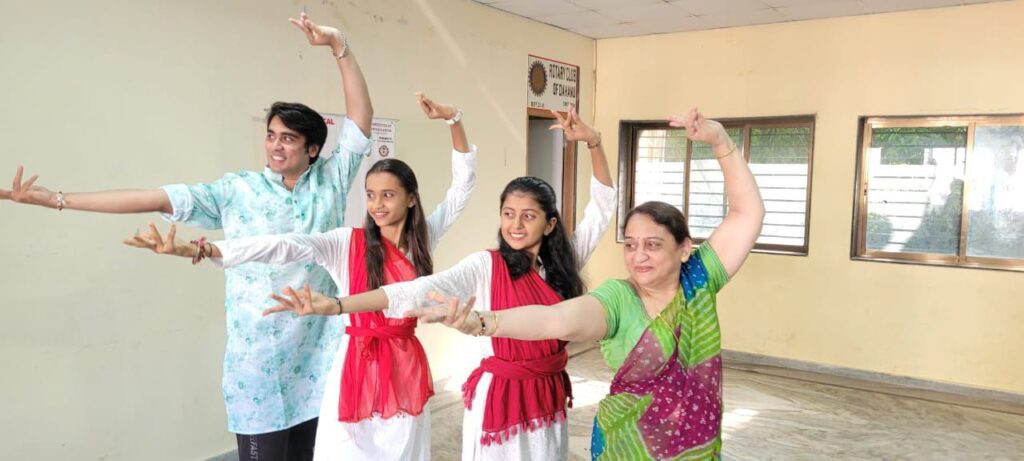Evolution of Classical Dance Costumes and Makeup: A Journey Through Time

Classical dance is a mesmerizing art form that seamlessly weaves together graceful movements, intricate storytelling, and captivating music. But alongside these elements, another crucial aspect that contributes to the enchantment of classical dance is the evolution of costumes and makeup. This blog post takes you on a journey through time, exploring how classical dance costumes and makeup have transformed over the years, reflecting cultural shifts, artistic innovations, and the essence of each dance style. 1. Historical Roots and Traditional Attire:Classical dance forms like Bharatanatyam, Kathak, Odissi, and more have deep-rooted traditions that are reflected in their original costumes. These costumes often feature rich fabrics, elaborate jewelry, and unique drapery styles. Makeup was minimal, focusing on enhancing facial expressions and maintaining a connection between the performer and the audience. 2. Influence of Socio-Cultural Changes:As societies evolved, so did dance costumes. Colonial influences, changing societal norms, and global exposure led to modifications in costume designs. For instance, ballet costumes in the West transitioned from heavy attire to lighter, more flexible outfits, allowing dancers greater freedom of movement. 3. Fusion and Experimentation:The mid-20th century saw a rise in experimentation, as dancers and choreographers began to blend traditional elements with contemporary aesthetics. This fusion resulted in innovative costume designs that retained the essence of the classical form while accommodating modern sensibilities. 4. Symbolism and Storytelling:Classical dance costumes are often symbolic, representing characters, deities, or emotions. Makeup plays a significant role in enhancing these representations. In Indian classical dance, expressive eye makeup and intricate face painting help convey intricate emotions and roles to the audience. 5. Technology’s Influence:Advancements in technology have enabled the creation of costumes with greater precision and ease. From lightweight materials that enhance movement to LED-embedded outfits that add a dynamic element to performances, technology has pushed the boundaries of costume design. 6. Sustainability and Contemporary Concerns:In recent times, there’s a growing emphasis on sustainable and eco-friendly practices in all fields, including dance. This has led to the exploration of natural dyes, organic fabrics, and thoughtful design to reduce the environmental impact of costumes. 7. Preserving Tradition in the Modern Era:Despite modern influences, many classical dance forms maintain a strong connection to their traditional costumes and makeup. Dancers and costume designers work to strike a balance between preserving the authenticity of the form while embracing the evolving demands of the art. 8. Individual Expression and Globalization:With globalization, classical dance has reached diverse audiences worldwide. This exposure has led to cross-cultural influences in costume design and makeup. Dancers often infuse their personal style into their attire, creating a unique blend of tradition and innovation.The evolution of classical dance costumes and makeup encapsulates the essence of artistic progression, cultural adaptation, and human creativity. From their historical origins to the contemporary stage, these elements continue to captivate audiences, telling stories that transcend time and geography. As classical dance evolves, so too will its costumes and makeup, a testament to the ever-changing yet enduring beauty of this art form.
Unveiling a Boon: Embracing the 15 Grace Marks in SSC Exams for Every Student

Introduction Education is a journey filled with milestones, challenges, and opportunities for growth. In this dynamic landscape, the recent introduction of 15 grace marks in Secondary School Certificate (SSC) exams has emerged as a beacon of hope for students across the board. This article explores how this provision is indeed a boon, leveling the playing field and fostering a more inclusive and supportive educational environment for all students. Leveling the Playing Field Elevating Mental Well-being Encouraging Lifelong Learning Promoting Inclusivity Guiding Future Reform The 15 grace marks in SSC exams represent a turning point in the education system, redefining success, and reimagining the path to excellence. This provision is not just a safety net; it’s a testament to the education system’s adaptability and its commitment to nurturing every student’s potential. As students across the nation embrace this boon, they are rewriting the script of their educational journey, embracing challenges with courage, and stepping towards a future where learning, growth, and inclusivity reign supreme.